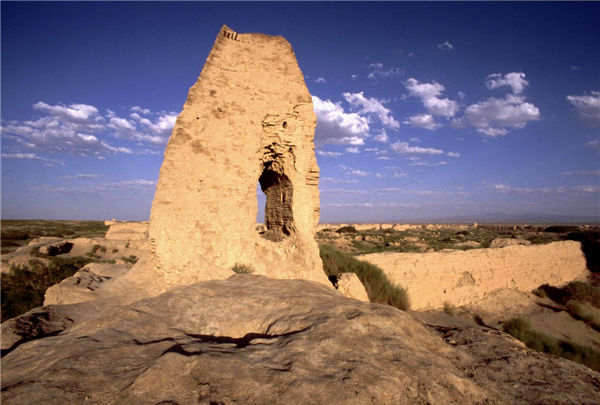 |
| Suoyang City ruins stand in the desert as a witness to the ups and downs of the Silk Road over the centuries. [Photo/China Daily] |
Ancient city ruins in China's western deserts battle the toll of time as officials and conservators seek to protect and preserve the heritage of the old Silk Road, Sun Yuanqing reports from Gansu province.
The air smells of sand. The sky has turned a murky, reddish color. The wind has become so violent that it is impossible to keep our eyes open or our feet firmly on the ground. The sand, whipped up by the wind, strikes the window sharply. This administration office of the Suoyang City ruins in Gansu province in Northwest China has become a little desert in itself. The only peaceful creature is the white puppy that the staff members have adopted, one of the few distractions they have in the desert.
Scattered through the Gobi desert, the Suoyang City ruins, along with other sites on a network of routes of Eurasian trade and cultural exchanges, has survived sandstorms like this for more than 1,000 years. Once the center of ancient civilization, the Silk Road waystations have been neglected, discovered, excavated and now await rediscovery.
Chinese officials and conservators are taking all kinds of measures to resurrect the route's former glory, in a joint initiative with Kazakhstan and Kyrgyzstan to seek UNESCO's World Heritage status for the Silk Road. The result is going to be announced later this week.
Not only have the relics been preserved, but the site has also been revamped to be more tourist-friendly. China has also launched ambitious efforts to turn the desert into an oasis that will better nurture the relics.
"The change is vast," says Cai Chao, executive director of the Gansu section of the Silk Road and architect at the Institute of Architectural History, a major planner for the project. "This area has always been a hot spot for experts and archaeologists. Now it has also become a place for ordinary people to look back at history."
The work started from within. In the Yumen Pass, a frontier pass leading to the north from the ancient Chinese territory, the missing parts are mended with adobe made from original material and ramming craftsmanship.
We recommend:
